How one heartbreaking decision by their mother, and the kindness of host families in Florida, helped the twin brothers fulfill their dreams of playing football.
It was time to go. Time to get back into her stepfather’s Lincoln Town Car for a 1,300-mile drive home, from Florida to Canada, and Raechel Brown could barely tolerate what she was doing. “I’m going to shove these kids back in the car,” she thought to herself.
She didn’t. Instead she forced herself to say goodbye to her twin 16-year-old sons, Chase and Sydney, leaving them in the care of a couple she had just met two days earlier. Racked with doubt and guilt, she knew in her gut that taking her beloved boys to this strange place was the best chance to do right by them.
“It was the most difficult thing I’ve ever done,” Raechel says. “It was totally unnatural, leaving your kids in another country with people you don’t know. I cried the whole way back.”
Raechel can say that now, with the gift of knowing it all worked out, as her boys star in the football revival at No. 17 Illinois—running back Chase, an unlikely Heisman Trophy candidate; safety Sydney, a captain of the nation’s No. 1 defense. But none of that was visible six years ago. She chose an option that broke her heart but gave her boys a chance to dream.
So she drove away, back to London, Ontario, where the family had lost their home. Chase and Sydney had to leave to pursue a future that included high-level football and greater stability. Canada was a hard place for players to get noticed by U.S. universities, and the family’s monetary situation had deteriorated.
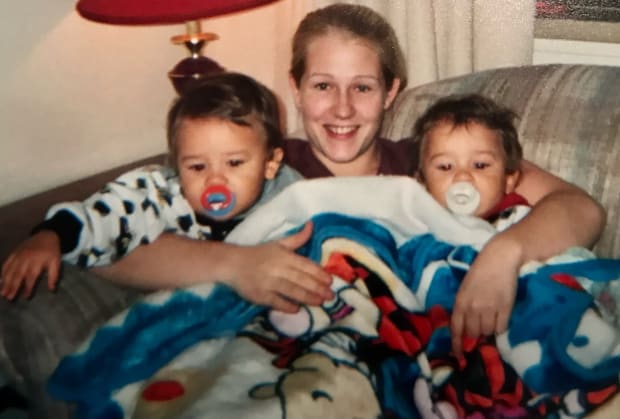
Courtesy Raechel Brown
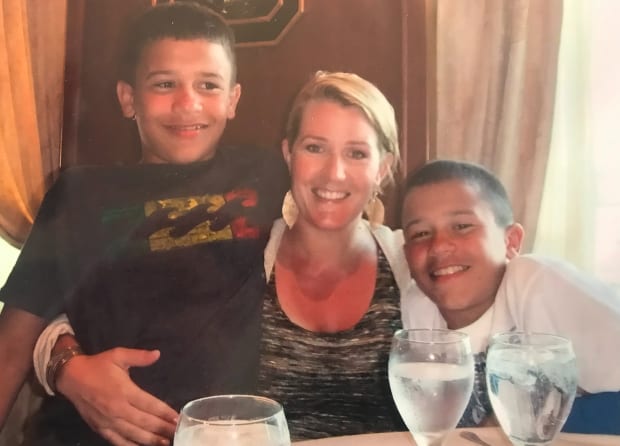
Courtesy Raechel Brown
Raechel says she became ill after the birth of her daughter, Mya, and was unable to work for an extended period of time. Then her father died, and a family member with mental health issues and a drug addiction had used most of the inheritance. “He became mine to try to help, but he couldn’t be on drugs and be in our home,” Raechel says. “The money from my dad went to him.”
The Browns were floating between living in a shelter and with Raechel’s mother. The boys were struggling in school. Looking for an alternative, they were connected by Canadian football talent scout Justin Dillon to a private school in Bradenton, Fla., Saint Stephen’s Episcopal School. It was August 2016, and the boys were about to start their junior year of high school. Everything began to move very quickly.
On a Friday afternoon, Saint Stephen’s football coach Tod Creneti called an old friend, Phil Yates. He was looking for a host family for two incoming players from Canada, of all places. “Oh, by the way,” Creneti said, “they’re really good.”
Phil and Karen Yates were empty-nesters, their two children having graduated from Saint Stephen’s. They had the room in their house, so they said yes to something they hadn’t previously envisioned. “There really wasn’t any question in our minds,” Karen Yates says. “But I remember lying in bed that Friday night thinking, ‘Is this really going to happen?’”
On Monday, Karen and Raechel talked on the phone. On Tuesday, the Browns began their drive down to Florida. On Wednesday, the Browns and Yateses had dinner together at a restaurant. On Thursday, they toured the school and had dinner at the Yateses’ home. On Friday, Raechel said goodbye and began her bereaved drive home.
It would get worse before it got better.
Raechel got back into permanent housing, but money was still tight. And now there was a tuition bill to pay for Saint Stephen’s. The Yates family gave Chase and Sydney beds and meals and transportation to school, familial structure and parental guidance where needed, but Raechel had to come up with the money to pay for school.
“Tuition or paying the rent was the choice,” Raechel says. “So we paid tuition.”
She lost her home a second time, moving back into a shelter. Raechel says she kept some of the reality of her circumstances hidden from the boys, not wanting them to worry or feel guilty.
“It was not something I really told them,” she says. “I just said they couldn’t come home.”
There was no going back for Chase and Sydney, only forward. Tough times and tough decisions have yielded to the current reality—the brothers are starring for one of the breakthrough programs in college football, their mom’s financial footing has improved and once-inconceivable professional goals are now in focus.
For this to become a happy story, it required several ingredients. It took a mother’s sacrifice, the kindness of strangers, a recruiting chance taken, a year spent apart, the prohibitive cost of aviation lessons, a transfer and ultimately the arrival of a new coaching staff that could shake Illinois out of its long malaise. Mostly, it took two boys’ acute appreciation of the opportunity they were given and unstinting effort to make the most of it.
“There was some stuff that pushed us out of Canada,” Sydney says of the family struggles. “That really told us, ‘O.K., it’s time to go. It’s really time to get it right.’ It’s been a journey.”
Sitting in a recruiting lounge within the Illinois football facility this week, you can tell the twins are finish-each-other’s-sentences close. They currently have different hairstyles, which is one of the few ways to tell them apart—both are about 6 feet tall and 200 pounds, similarly sculpted. From a demeanor standpoint, Sydney is more animated and intense—the neat one at home, to the point of obsessiveness. Chase is more reserved and laid-back.
They are fastidious about nutrition, fanatical about workouts and driven to make the most of what likely will be their last football season together. “It’s something we’ve worked for, so it’s been well deserved, but the work’s not done,” Sydney says. “Still got a lot to go. We’re focused on Nebraska this week and the process for that game, but I can’t imagine what 9–1 would be like going into the Michigan game [Nov. 19].”
A 9–1 Illinois playing what could be a 10–0 Michigan team would indeed be a stunning turn of events. But really, the Browns’ personal odyssey since childhood is every bit as unimaginable.
The boys were always quiet in public, going until age 12 before they could summon the nerve to order for themselves in a restaurant. But they were rambunctious at home, always competing, occasionally fighting. They played several sports and loved martial arts, but never played hockey. Eventually they gravitated to something with only niche popularity at the youth-league levels in Canada—football.
The country has produced a steady pipeline of college basketball talent to the U.S. In football there have been a few standouts—Chuba Hubbard at Oklahoma State, John Metchie at Alabama, Jesse Luketa at Penn State—but it’s a comparative trickle.
Strong, fast and tough, the Brown brothers were well suited for football. Some of the men in their family had played football, including their father, Darren Isaac, but it was utterly foreign to Raechel. “It’s just not something kids from our part of the world get to experience,” she says, then laughs. “For a long time I didn’t even know what Sydney’s position is. I knew he stopped players from getting touchdowns, but that’s about it.”
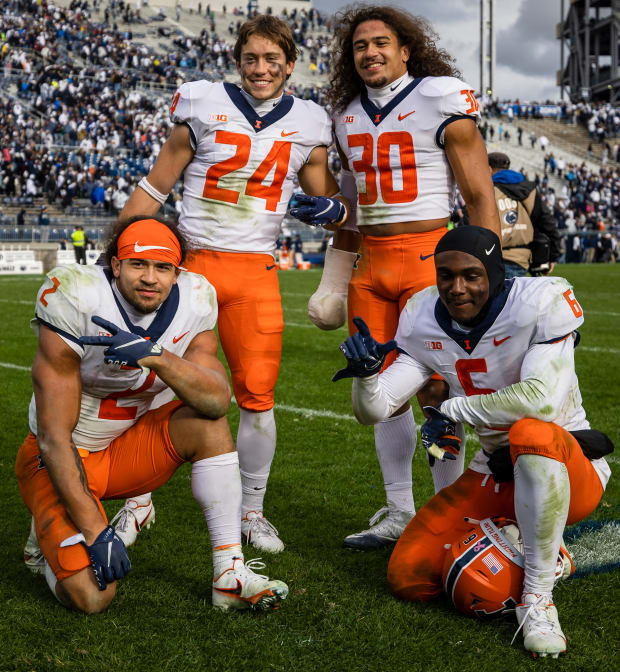
Scott Taetsch/Getty Images
Commensurate with the scant local interest, the coaching and financial investment was minimal compared to the sprawling business of youth football in the U.S. The Browns’ talents outstripped their surroundings, which spurred some of the initial interest in American options. And Florida was the football Promised Land. Still, when the boys arrived in Bradenton, they weren’t even thinking about going to college. Saint Stephen’s was an opportunity to play ball and improve their grades. It took a while to entertain the idea of higher education and Saturday games in big stadiums.
The Browns helped Saint Stephen’s program hit a new level, as the team went undefeated in the brothers’ junior and senior seasons and won two State I-A championships. Phil and Karen Yates gave them a starting point, but the boys supplied their own motivation to excel on the gridiron.
“They had the foundation laid before they ever came to us,” Karen Yates says. “Raechel and their grandparents, they’re just good people. I’m just so in awe of Raechel to have the courage and forethought to bring her kids to Florida.”
Phil Yates got a new job in Dallas during the boys’ senior year, which put their living arrangements in flux again. That’s when some neighbors stepped up. Michelle Cross drove into the neighborhood one evening to find Chase walking the Yateses’ dog, and stopped to ask him whether they’d found a new host family. The answer was no. She went home and talked to her husband, Tom, about taking in the Browns. They had two young sons of their own, but decided to do it.
“To our sons, Chase and Sydney were superheroes,” Tom Cross says. “They thought it was the coolest thing ever. They set good examples. I’ve not encountered many people at 17 or 18 who were as hardworking and motivated as they were. They worked their butts off. Both were very aware of the opportunity they were presented with.”
As their exploits grew, college recruiters followed. Phil Yates spent time tutoring them in various subjects, an undertaking that proved especially satisfying when both boys scored well enough on the ACT for immediate college eligibility. Chase, born two minutes earlier than Sydney, was the more obvious prospect, drawing a three-star recruiting rating. But he committed in October 2017 to Western Michigan and didn’t waver when offers came in from Power 5 conference programs. The biggest reason? Western Michigan’s aviation program. Yates was a pilot, and Chase thought it looked like a great life.
“He would fly to the Bahamas one day, fly back,” Chase says. “I thought that seemed cool. I wanted that. He seemed happy, and I just saw myself doing that. I would have hung up the helmet and continued that dream that I had. Any school could have offered me at that point, but I was just so invested in following that dream and that goal.”
Sydney, meanwhile, was a two-star prospect who didn’t receive much interest from FBS schools. He visited Illinois and Tulane and wound up committing to the Illini. On signing day, he was just another name in small type in then coach Lovie Smith’s modestly rated recruiting class. At that point, and against their mother’s wishes, the twins went their separate ways. Both made immediate impacts—Chase as a running back and kick returner at Western Michigan, Sydney as an aggressive safety at Illinois.
They might have continued on those divergent paths if it weren’t for an unwelcome surprise Chase encountered at WMU: flight classes cost up to $60,000, and his scholarship wouldn’t cover those expenses. That spurred interest in transferring, and Sydney said good things about Illinois. Chase matriculated to Champaign, and the boys resumed living together.
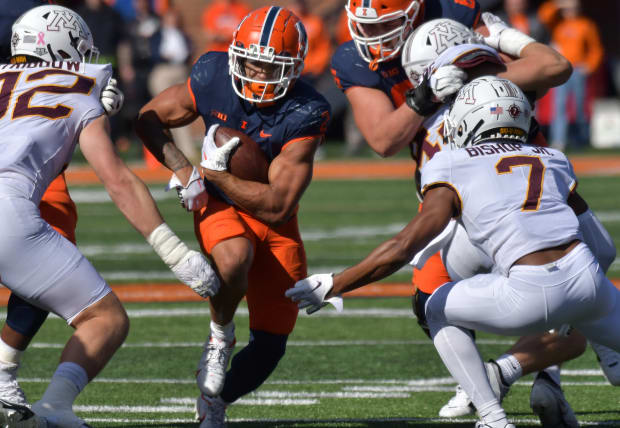
Ron Johnson/USA TODAY Sports
Chase redshirted in 2019, playing the maximum four games but not making an impact. Sydney continued to play a big role at safety, finishing second on the team in tackles. Illinois made a bowl game for the first time since ’14, but finished the season 6–7 and on a three-game losing streak. That put Smith on the hot seat for ’20. Chase became Illinois’s leading rusher that season, and Sydney again was a key player on the defense. But the Illini went 2–6, and Smith was fired. Still, the Browns held firm in their commitment to the school and to each other. “The portal was an option, but without a plan, the transfer portal is a mess, to be honest,” Sydney says.
Enter new coach Bret Bielema and defensive coordinator Ryan Walters. Sydney’s role remained constant on defense, while Chase’s grew on offense. Bielema has always loved a run-based offense and has turned running backs into stars at Wisconsin and Arkansas. But first, Bielema had to learn what not to do with Chase and Sydney—namely, not pit them against each other in practice. During one scrimmage situation in 2021, Sydney was blitzing when Chase was in on pass protection. The collision in the backfield sparked a confrontation. It might have looked familiar to their mother but came as a shock to the new coaching staff.
“It did not end well,” Bielema says with a smile. “I had to throw them both out of the scrimmage. I literally got done with that scrimmage and told my staff, ‘That will be the last time we see the Brown brothers together on the field in a live environment.’ It didn’t do us any good to have those two fighting over who was better.”
But Bielema knew this much: He had two vicious competitors to build around.
Chase Brown was banged up and sharing time through the first five games of the Bielema era in 2021. The Illini were 1–4 and hosting Charlotte when Chase erupted for 257 yards on 26 carries in a 24–14 victory. From that point forward, he became the barometer for Illinois success. When Brown rushed for more than 100 yards in a game, the Illini were 4–0 (including a road upset of Penn State, in which he had 33 carries for 223 yards). When he ran for fewer than 100 yards, the Illini were 1–5. When he didn’t play, they were 0–2.
This season, it was clear from the start Chase would be the hub of the Illinois offense. The better the competition, the more he touches the ball—and the better the results. In three blowouts of nonconference competition, Chase averaged 19.7 carries. Against Big Ten competition, that number jumps to 33.3. And in the past two games, against Iowa and Minnesota, Chase has seven receptions for 70 yards and a touchdown.
His 192 rushing attempts (27.4 per game) lead the nation. So do his 1,059 rushing yards. By the time his season is over—he still has another year of eligibility but will assuredly turn pro—he should easily be the school’s No. 2 all-time rusher. And he will be another entry on Bielema’s list of great backs. The coach had Montee Ball, Melvin Gordon, James White and John Clay at Wisconsin—all of them running for between 3,400 and 5,200 career yards. He had Alex Collins (No. 2 all-time rusher at Arkansas) and Jonathan Williams (No. 11).
But Bielema sees a running versatility in Brown he hasn’t had before. He listed the three traits good backs have: the ability to run away from tacklers, run through tacklers and make tacklers miss. “Backs usually have one or two, but not all three,” Bielema says. “Chase has all three.”
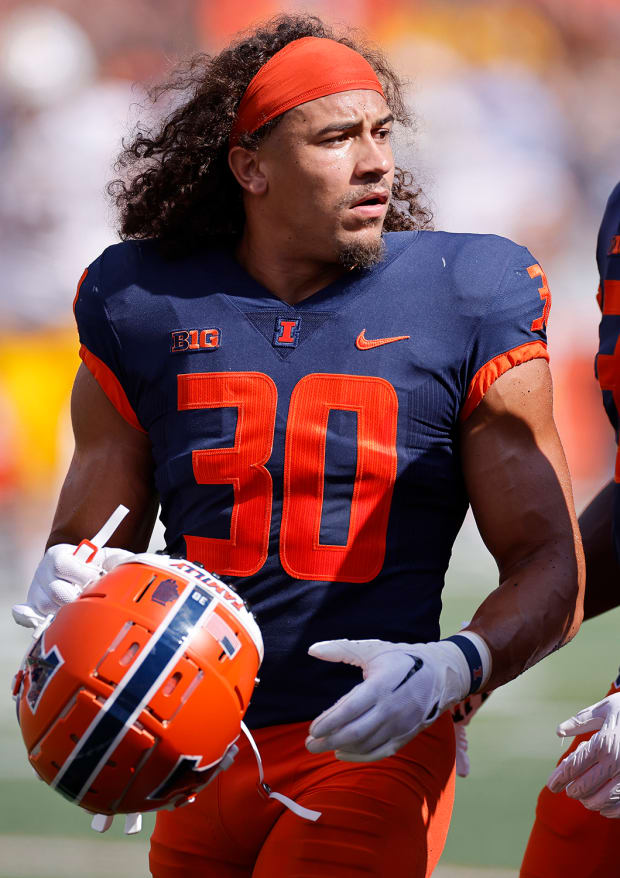
Joe Robbins/Icon Sportswire/Getty Images
If Chase keeps piling up yards and Illinois keeps winning, he will move more prominently into the Heisman discussion. Illinois has a puzzlingly meager football history, and the school’s top Heisman vote-getters reflect that. The Illini haven’t had a top-10 finisher in 40 years (Tony Eason was eighth in 1982) or a top-five finisher since Jim Grabowski was third in ’65.
Sydney, meanwhile, has served as an anchor on a defense that leads the nation in fewest yards allowed per game (221.1), fewest points allowed per game (8.9) and pass-efficiency defense (75.4—which is probably not sustainable through the season but would be an FBS-best in more than a decade). Sydney is tied for second on the team in both solo tackles (18) and passes broken up (seven), in addition to having an interception and a forced fumble.
Phil and Karen Yates, the Browns' original host family, watch all the Illinois games with beaming pride. They’ve been to Illinois games in 2019, ’21 and this year, and they plan to attend whatever bowl game the Illini play in. Tom and Michelle Cross have trekked to Champaign as well for games, watch more on TV and try to FaceTime with the twins every few weeks.
“We got as much from the experience of hosting them as we gave,” Tom says.
For Raechel, the hardships of 2016 have been replaced with a joy she couldn’t see coming beyond unquestioning belief—in her sons, and in the help of strangers. But she gave her boys a chance, as difficult as it was, and they have rewarded her sacrifice abundantly.
“They’re so hardworking and so dedicated in everything they do,” she says. “They deserve this so much. They’ve done so many things we’ve never imagined.”
More College Football Coverage:
• Who Could Play Spoiler to Playoff Contenders?
• Bowl Projections: New Year’s Six Shakeup
• Rising Coordinators Who Could Get a Head Job